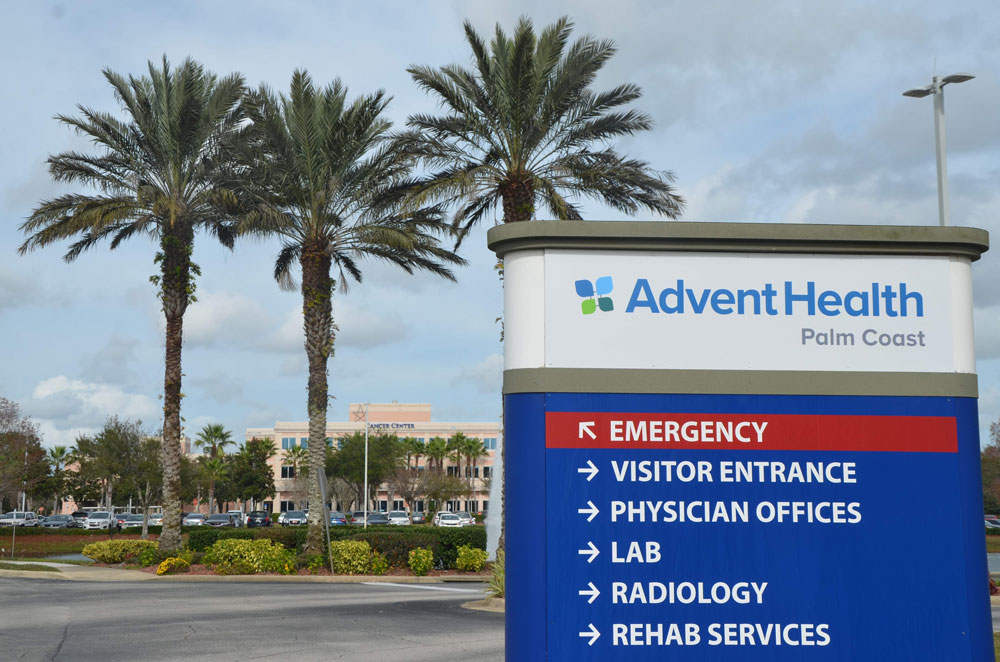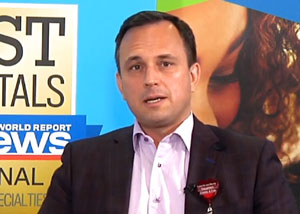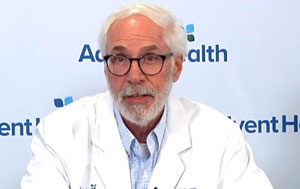
As Flagler’s hospital reopens for procedures, doctors’ visits and visitations, your experience at AdventHealth Palm Coast is going to change in light of the coronavirus emergency, with new requirements, restrictions and protocols, some of them a bit inconvenient or intrusive, and some of them making the experience more convenient than previously.
On the inconvenient side, all individuals in an AdventHealth facility will be required to wear masks at all times, whether guests, visitors, patients, staff or doctors. All entrants to all facilities will be temperature-tested. Visitations, closed for the past month, will be limited to one visitor per patient until further notice, but possibly even for Covid-19 patients: that depends on the availability of personal protection equipment.
All patients, in the emergency room or elsewhere, will be tested for the virus, whether they are showing symptoms or not. The testing will be saliva-based rather than involve the sort of brain-grazing intrusion through nostrils.
On the more convenient side, check-ins and check-outs will now be done virtually, using phones and other means, and patients will be able to wait for their appointments in their own car until they’re called.
Visitors will notice a lot of new signage and procedures intended to ensure social distancing behaviors in the building. The interiors of AdventHealth facilities will have floor decals and signs on chairs that actually tell you not to sit there. Visits to doctors’ offices will be different than what you’ve been used to, minimizing waits in waiting rooms or at counters.
It all starts Monday.
Three AdventHealth physicians from the network’s central region presented the roll-out, including startling numbers and reflections about a “mountain” of fatalities not necessarily related to Covid-19, an astounding proportion of fatalities to Covid-19-positive individuals who have undergone elective surgeries, and sobering numbers about the financial hit AdventHealth sustained over the last several weeks.
They also addressed the question of models, cautioning against Gov. Ron DeSantis’s simplistic and misleading conclusion on Thursday that the models were all wrong. Rather, they said, the models did what models are intended to do, as in the case of hurricane forecasts: they warned of worst-case scenarios, allowed for preparations, were adjusted, and allowed for further adaptation, all the while compelling residents to do what was necessary to improve the forecast. They did.
The trio spoke in a 40-minute virtual news conference this morning, including questions texted by reporters. The physicians included Scott Brady, a Senior Vice President of Ambulatory Services for the AdventHealth Central Florida Division, Daryl Tol, president and CEO of AdventHealth Central Florida division, and Neil Finkler, Chief Medical Officer for Acute Care Services at AdventHealth. They spoke from a single location.
How to Reopen Safely
Their message: It’s a safe time to reopen, but communities have to still take precautions against a spiral of a virus without a cure or a vaccine, and hospitals and health care facilities even more so.

Now that it’s time to reopen segments of society, the hospital system has been preparing for what will be a new norm for most who go there.
“We believe we can do this safely and watch it very closely,” Tol said. The hospital system has adequate personal protection equipment, it has “significant open beds ICUs, ventilators” and is ready to get back to certain types of procedures that had been stopped. He made an analogy with the aftermath of 9/11, which altered society in ways that have persisted to this day. He expects similar changes to remain in place subsequent to the Covid emergency.
“We will be restarting elective procedures, ambulatory procedures across our health systems on Monday. We’ve been preparing for this for some time,” Tol said.
The system will take steps beyond the base requirements. For example, every AdventHealth employee and physician is being tested on a continuous or surveillance basis. Hospital patients will be tested whether they’re entering the hospital through the emergency room or for other reasons. That’s intended to protect both patients and staff.
Isolating Covid-19 Down to Isolated Air
Non-positive individuals should not fear catching the virus for going to the hospital.
“We will continue to cohort Covid-positive individuals,” Tol said. “That means they’re placed in isolation environments. We have high-tech rooms that don’t allow the air from that room to leave that space, and that has been a critical aspect in keeping the Covid issue in our facilities in special units where we’re professionally ready to care for those environments. That will continue.”
The detail about air-conditioning is key, because Centers for Disease Control research recently published indicates that air conditioning played a role in spreading the virus around a restaurant in Guangzhou, China, where a family had been dining after traveling from Whuhan, there the virus originated. Ten people ended up infected after that dining period, even though the diners at other tables had not had contact with the family of travelers.
People who come into the ER or for other services who are not positive will not be in spaces that are “interacting” with Covid individuals.
The hospital network now requires all its staff members, all its physicians, and all its guests to wear masks: earloop masks for visitors and guests, N95 masks for anyone suspected of having Covid-19. That’s a requirement, not a recommendation. “We will provide you with a mask when you come into our facilities, or if you have one that will be fine, we’ll check that mask to make sure it’s effective,” Tol, said.
Telehealth has exploded during the emergency. “We want to continue to accelerate that work,” Tol said. “It is a perfect social distancing technology.”
Social distancing will not stop–anywhere. “Social distancing in every facility has to be taken really seriously, and our sanitation procedures, the deep cleaning of our environment, deep cleaning of equipment after use or before use, deep cleaning of the seat you were sitting in before the next person sits in that seat, very important protocols are being developed there,” Tol said.
All of this is geared toward keeping the infection curves low, recognizing that the virus is untamed: a vaccine is not expected until at least January 2021, if then.
One of the virus’s greatest threats is its stealthiness: it lurks in individuals who are asymptomatic. The proportion of asymptomatic Covid-19 persons has fluctuated widely. It was initially believed to be low. It rose to 25 percent in early April. Researchers have been pushing that proportion higher since. Masks keep an asymptomatic individual from shedding that virus. “We need to have the masking until proven otherwise,” Finkler said.

What DeSantis Got Wrong About Models
The physicians were asked about DeSantis on Wednesday ridiculing models that had projected many more deaths than Florida experienced. Were the models wrong?
“Yes they were all wrong and some of them were useful. That’s how models work,” Tol said at the beginning of a detailed answer that clearly sought not to criticize the governor while still explaining the governor’s deeply flawed reasoning.
Tol continued: “The best models tend to have a series of projections based on observations of other areas and the mathematical behavior of the situation that you’re modeling. As you feed the actual into that, then the models shift, based on the actuals. The smartest models are updated every day or every few days. The fact they shift is because they’re smart, not because they’re wrong. If they didn’t shift, there’d be a major flaw in the model. The great thing is human actions and leadership actions shift models because human actions change reality and reality changes the models. So what we saw with the models, and some seemed a lot further off than others–the governor used some really extreme examples that I would say, wow, that wasn’t observed anywhere to that degree, and I think he made a good point about needing to be cautious with some of the most extreme examples. You have to be cautious too with your own confirmation bias around wanting it not to be bad at all. That would be a problem, just as overstating the problem would be a problem. So for us being health care leaders in a community and feeling the entire responsibility to take care of and protect people in our community, we don’t feel responsibility to a point after which it’s the government’s problem. We feel the total responsibility on our shoulders. So using models, somewhere in the middle of the range, has helped us prepare: what if we had to double our ICU beds, what if we needed more vents. I think you’d want us to be prepared. We’re the kind of place that isn’t going to say, well, the hurricane will turn away. We’re the kind of place that’s going to say: all right, if it hits us, will we be ready? And that’s how we’ve used models.”
Brady added another caveat: “Many of the models didn’t have the ability to calculate what would happen if we social distanced like we did,” he said. “One model did, and if you pressed 15 percent of us would stay at home, the model was really high. Fifty percent, it started getting lower, and 80 percent was really low, and guess what: you did it, so thank you, thank you for what you did, thank you for staying home, thank you for social distancing, and we’re going to continue to need you to continue to take the safety measures as we reopen.”
To also addressed AdventHealth’s financial experience during the emergency, though he did not say exactly how much loss it sustained. But no one was laid off.
Revenue has dropped substantially, with “hundreds of millions of dollars” lost, Tol said. “We have not had people go, we have not had layoffs, we have not had furloughs,” he said, with employees “redeployed” to different duties if their own department was slow or shut down, and with thousands working from home. “As we get back to work,w e do have our full team in place but we do expect significant losses compared to our normal because revenue is way down, and we kept our expenses up by maintaining staff in place, which we think was the right decision.”
Unexplained Deaths
The physicians say the last two and a half weeks have seen steady, slow declines in Covid-19 cases and patients, and sustained support from communities around their hospitals.
“I have a great sense of gratitude for our community,” Tol said in closing. “The outpouring of support has been incredible. It’s something that our whole team gets emotional about. People who work in health care signed up for this, but the fact that you recognize the sacrifice they make and have just been there for us is unbelievable, and I want to thank you for that.”
But Tol also spoke of the astounding death toll research is beginning to reveal across the United States even after Covid-19 deaths are accounted for
“One thing we know is that this virus is real and that people are becoming ill and they are dying from the virus, and that our actions matter,” Tol said. “One thing that we see during this period of time as other countries are studied is a significant spike in mortality beyond the normal, beyond the normal attributed to positive Covid tests, this unknown mountain–truly a mountain–of mortality that happens over two or three months when this is really active in a community. Part of that is Covid, part of that is untested Covid, the impact. We worry part of that is the people do become afraid, and they don’t seek care for non-Covid related, really important illnesses, things that can be fatal if not addressed, and are very treatable if addressed. Our goal is to create an environment that is very, very reassuring and safe for people, so that everyone knows: when you need health care, go get health care. We’re here, our teams are here, they’re ready.”
![]()
AdventHealth April 30 News Conference:
AdventHealth April 30 News Conference from AdventHealth Events on Vimeo.





























Leave a Reply